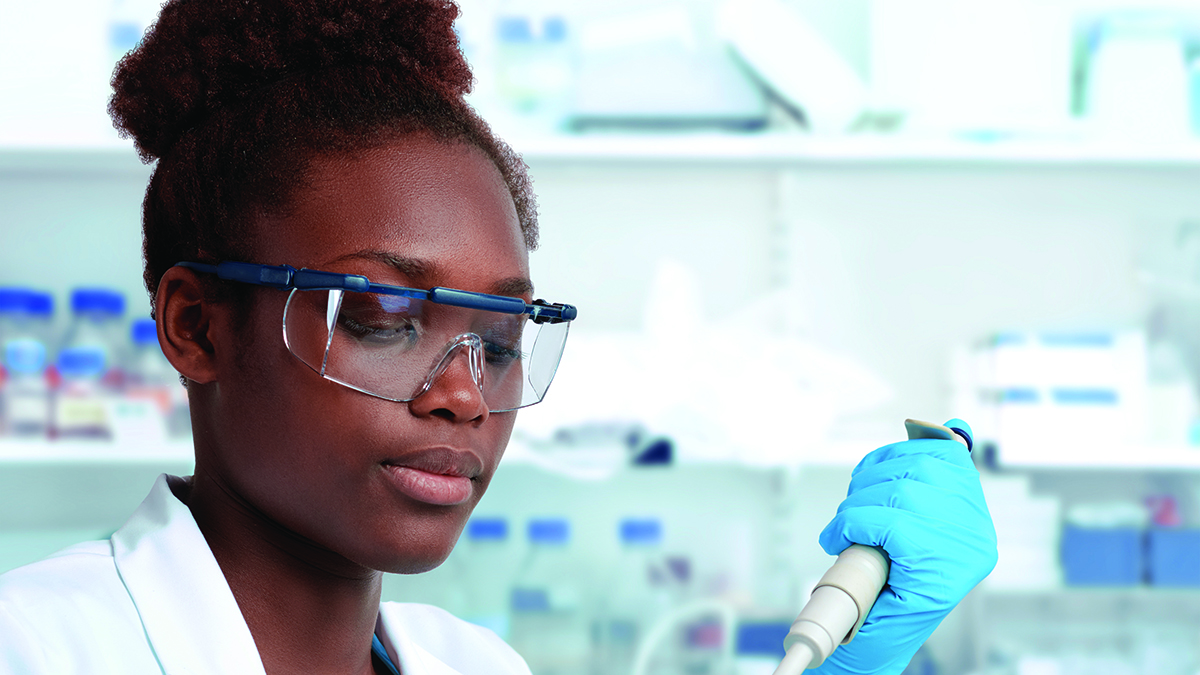feature
Who Does Science?
Using data to explore society, inequality, and social justice in the context of science
For many years, I didn’t know that social justice could be a part of my science teaching. I had been taught that science was a purely objective process, unrelated to the humans who practiced it (beyond, perhaps, a few examples of geniuses seemingly born to do it), existing contentedly above the fray of humanity. The ways in which I was taught science reflected this apolitical view; we learned the content, rarely applied it, and never talked about the nature of science itself.
It is easy to see that the biases present in American society affect the practice of science as well. Underrepresentation is endemic across disciplines and across time (National Science Foundation 2019), and extensive research clearly shows that this reflects bias and a lack of access, not a lack of ability in students from those underrepresented groups (National Research Council 2012). Systemic injustice is present in the teaching (Moss-Racusin 2012), learning, and practice (Leslie, 2015) of science, both historically and today.
This is a moral problem, and also a pragmatic one. Research has shown that less-diverse scientific groups do less impactful work (Freeman and Huang 2014). Moreover, a purely objective view of science is simply not an accurate one. The Next Generation Science Standards clearly state that “science is a human endeavor” and remind us that “science and engineering are influenced by society” (NGSS Lead States 2013) (see NGSS Connections box for other connections to education standards).
Crucially, nobody is better positioned to address these systemic imbalances in science than science teachers. As Editor Ann Haley MacKenzie recently wrote in these pages, “schools and science classrooms should be places for a more just society than currently exists.” (Mackenzie 2018) We must help our students see through science how society needs improvement and give them tools to bring it about. Taking steps to undo the systemic imbalances around us is how I define social justice, and helping students to do so is how I define teaching for social justice (Teaching Tolerance 2018). But few resources exist for science teachers who want to bring social justice into the science classroom. In this article, I share one such resource and how I implement it.
The Underrepresentation Curriculum
The Underrepresentation Curriculum (URC) is a free set of lesson plans and resources, created and curated by a group of science teachers, to help fellow science teachers bring social justice to their classrooms. The URC begins with a question: does the population of scientists match the population of America? This question can be answered by giving students access to freely available datasets (National Science Foundation 2019; U.S. Census Bureau 2019) and asking them to make the comparison. Teachers can focus by discipline and by whichever aspect of demographic identity they choose. Since I am a physics teacher particularly dedicated to anti-racism, for example, my students explore how physicists identify by race.
Through this comparison, students gain relevant experience with the science and engineering practice (SEP) of Scale, Proportion, and Quantity and the crosscutting concept (CCC) of Obtaining, Evaluating, and Communicating Information. The question of “match” is a mathematical one; students often reach for graphs as a way to organize their thinking (Figure 1). In my class, for example, students come to see that white Americans are roughly three times as likely to become physicists and astronomers as black Americans.
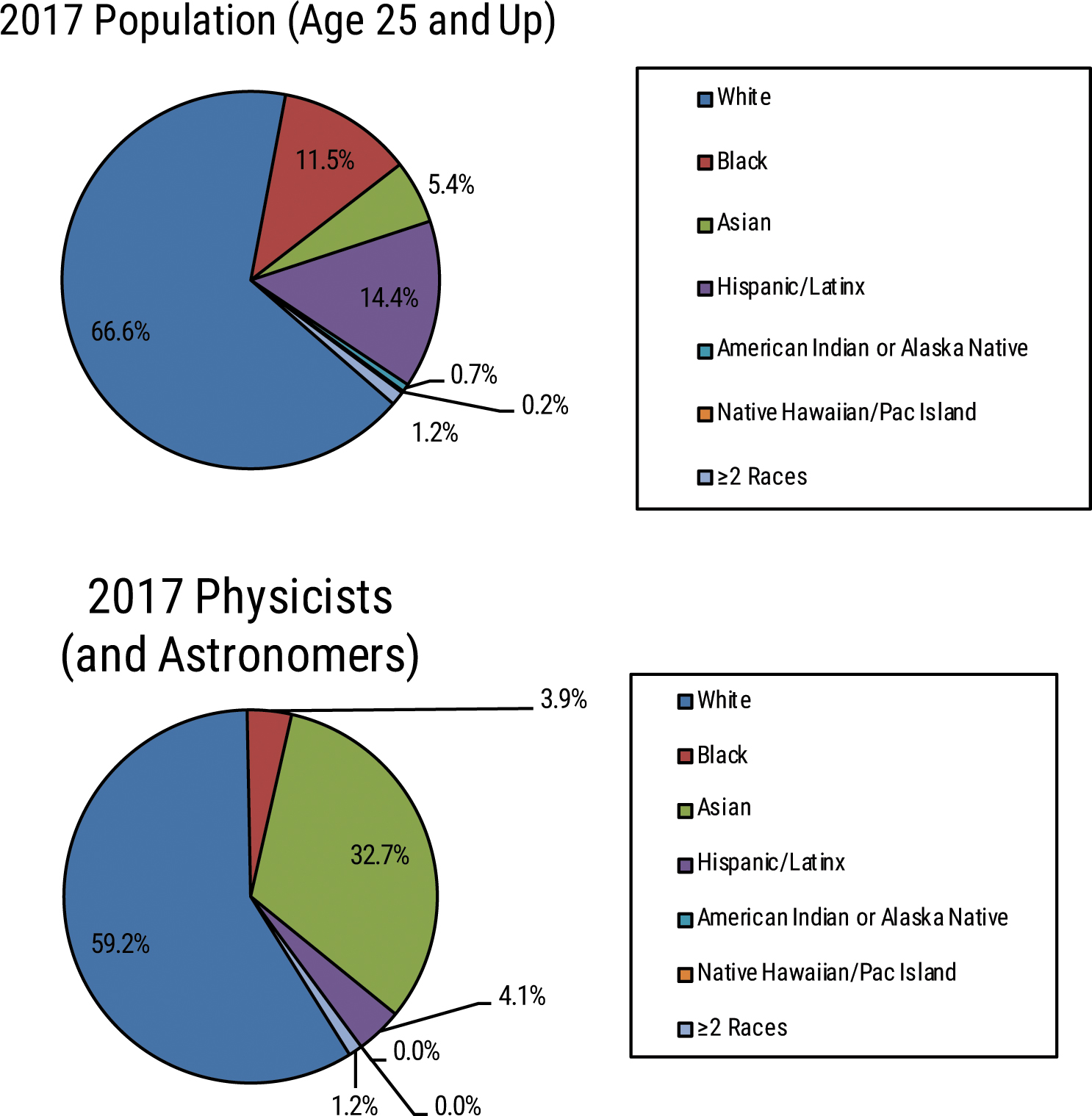
Pie charts comparing racial identification of U.S. population to the racial identification of U.S. physicists and astronomers
This is a new twist on a familiar idea: using an anchoring event to motivate student engagement. As described in Ambitious Science Teaching (Windschitl, Thompson, and Braaten 2018), an anchoring event is “any complex phenomenon for which students can develop models and explanations over the course of a unit … What all good anchoring events have in common is that they motivate students to try to explain what is going on.” In my class, this engagement is clear; students immediately jump into asking questions about the data they see, and I steer them towards generating hypotheses for the inequality.
From there, they research the validity of their hypotheses—Are white students more interested in majoring in physics? Do black students have equal access to high school physics?—and share what they’ve learned with their classmates. In this unit, it is an observation of science itself that is the anchoring event, and students use the tools of science to revise and improve their model of how science is influenced by society.
Each context is different, with different emphases, curricular flexibility and student interest, so the URC lessons are modular and flexible. Teachers can choose the parts that work for their setting, and modify them to fit their needs. Figure 2 shows two examples of implementation by teachers. The first shows how my high school seniors explore race in the context of physics over seven class periods, and the second comes from the AP Chemistry class of a colleague exploring sexism over four class periods. This flexibility makes it more challenging to write a description of how the URC looks in practice, so in this article I describe three key lessons that many teachers tend to include in their implementation of the URC in detail.
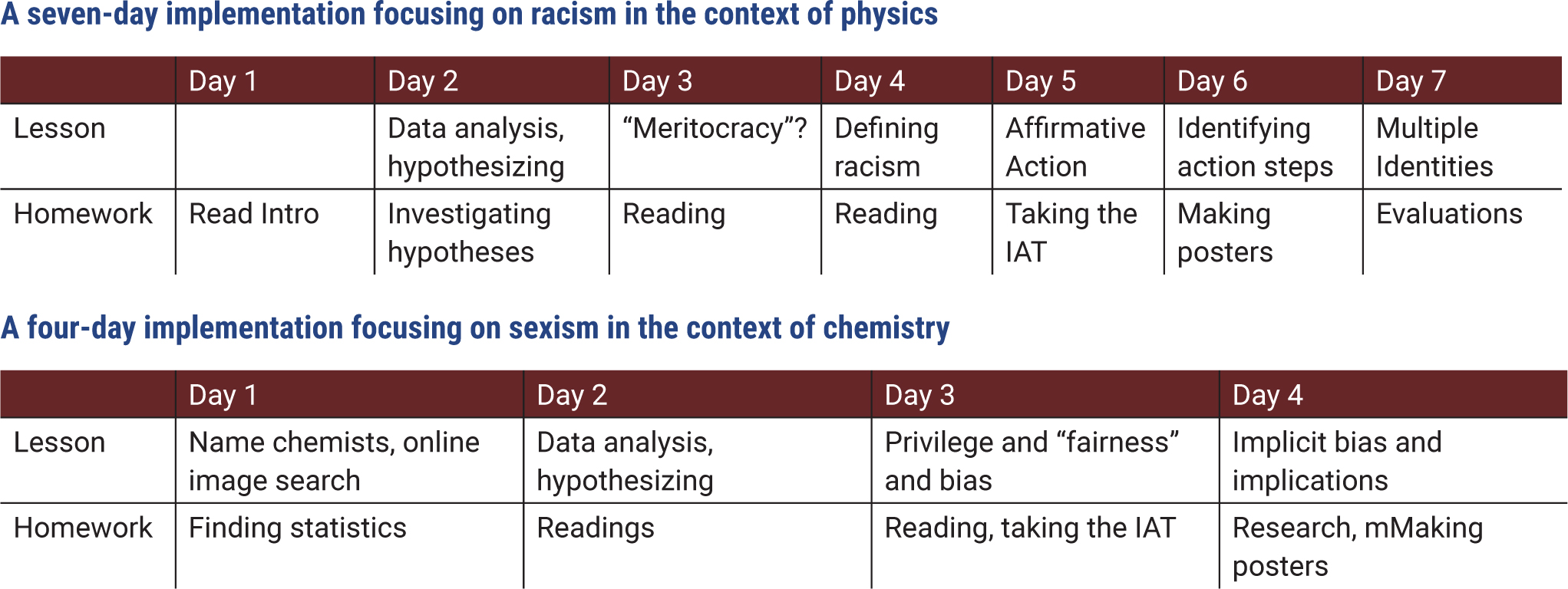
Two different implementations of the URC.
Examples of implementation
Having recognized and explored the lack of racial diversity in physics, I ask my students whether they think it matters to the field. Embedded in this question is another about the nature of the science itself: is physics objective or subjective? If it is objective, if it exists outside of human experience, then perhaps racial demographics aren’t relevant to the practice of physics itself.
As described in Daane (2017), I ask them to stand in a line across the room, making a spectrum from objective to subjective based on their current views of physics, and then partner with a peer standing in a different location to share their thinking. I encourage students to try to be as convincing as possible when they speak and as open to being convinced as possible when they listen, and when we reform the spectrum after discussion it has often shifted.
There is no “right” answer revealed at the end—the point is to develop their thinking and to understand how others might think differently (Figure 3). Nonetheless, preliminary observations suggest that the conversation tends to leave students moving towards more subjectivity in their understanding of physics, which aligns with the NGSS CCCs “science is a human endeavor” and understanding that “science and engineering are influenced by society.”
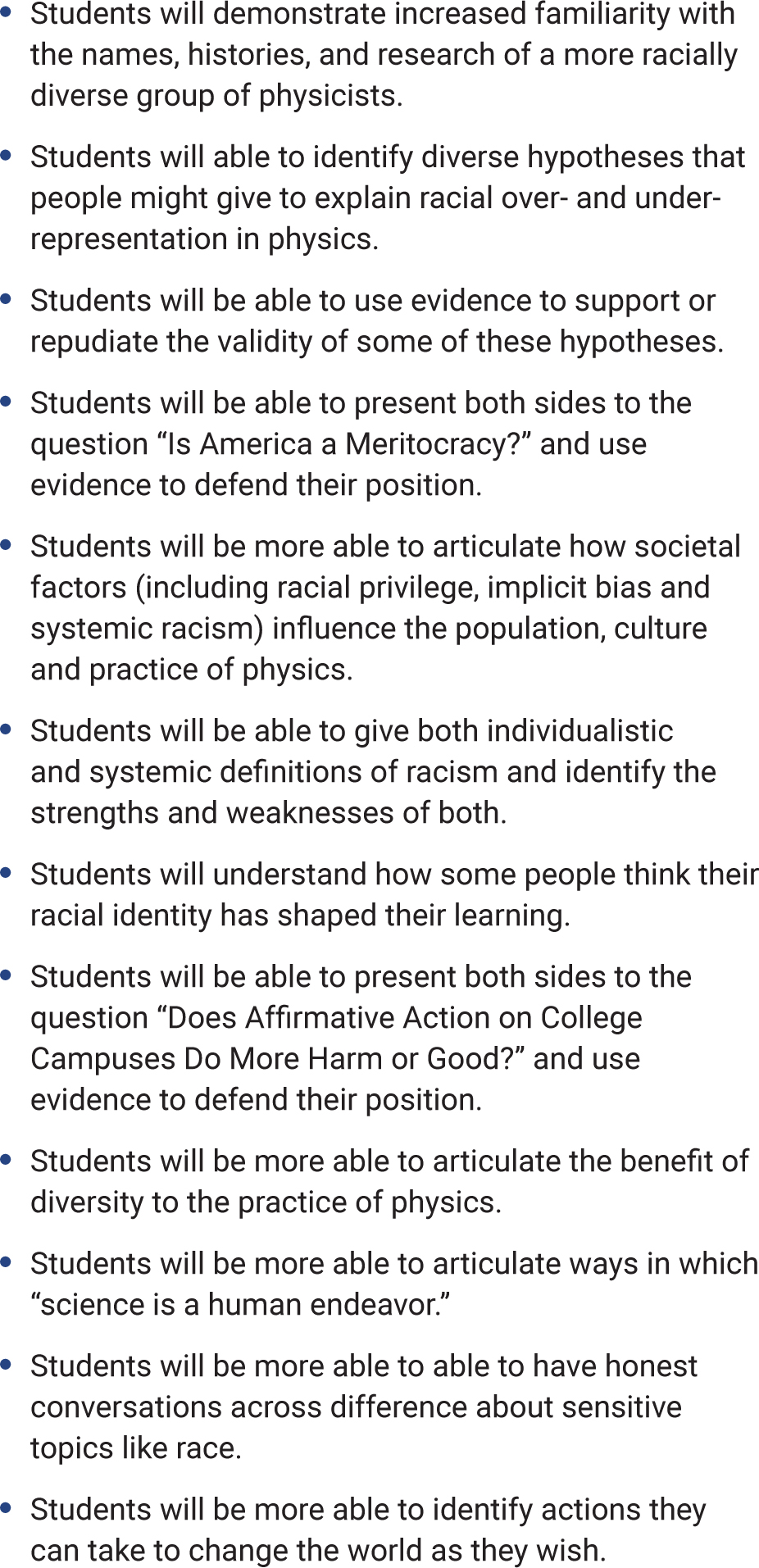
Learning Objectives for my URC.
In addition to students’ own experiences and perspectives, I use case studies to organize discussion of related topics. When they are generating hypotheses to explain disproportionate representation, inevitably a student suggests “racism.” When I press for more detail, it becomes clear that different students are using different definitions of this word. They know from our previous explorations of acceleration and work that precise definitions of words matter, and that an expert’s definition can differ from a layperson’s. I ask them to put into writing how they define racism and share with them the case of Paul Sherley, a scientist denied tenure. Sherley claimed his rejection was because of racism, whereas the university suggested it was not (Bhattacharjee 2007). I ask the students whether this fits their definition of racism. Having a concrete example leads to animated revision, thoughtful reflection, and engaged discussion.
The discussion that follows often leads to a more systemic, less individualized definition of racism; this, I’m happy to share with them, aligns with the definition that experts in the field use (Kendi 2019). I generally finish with my students reflecting on the costs of systemic racism to them and their communities, not only because making it personal can make it meaningful, but also because it helps to reinforce the last discussion norm (“we are all in this together;” see Facilitation and Figure 5) and how systems of oppression hurt us all. By the time we loop back to the anchoring event of disproportionality in physics (Figure 1), students tend to see and understand the pie charts in new ways.
No matter what lessons teachers choose in their implementation, closing with a lesson about taking action provides a powerful culmination. We live in a time when our students see their peers taking and leading effective political actions at a national and global scale, and creating a curricular space for students to apply what they’ve learned feels like an opportunity to create the more just society that Ann Haley MacKenzie wrote of recently.
Students not used to thinking of themselves as agents of social change sometimes balk when asked what action they’d like to take, and so the intentional scaffolding offered by the URC lesson plan is helpful.
I begin by asking students to reflect on what they’ve learned throughout this unit, and to reflect on what resources—influence, experiences, interpersonal skills, and so on—they have to make change. We use “chalk talk”-style whiteboard conversations (Elliot et al. 2017) to get the conversation going, and I intentionally frame the question in terms of collective action: what steps do we want to take to make a difference in our school, in our city, and beyond? I have learned that it is important to keep the focus on taking action now (not someday), and that students always rise to the challenge.
Throughout the URC, students are given the freedom to come to their own decisions and I’m routinely amazed by their ambition, engagement, and ability to take concrete steps to make the world more just. If science teachers are to help students see how society can be improved and help students bring about change, the URC offers a powerful template that leads to action. Recent STEM-related student actions included designing and delivering a lesson about underrepresented racial minorities in our school’s attached middle school classrooms, a letter to the administration advocating for the hiring of more science faculty of color, and the creation of a mural of physicists that hung in our school’s entryway for several weeks (Figure 4).
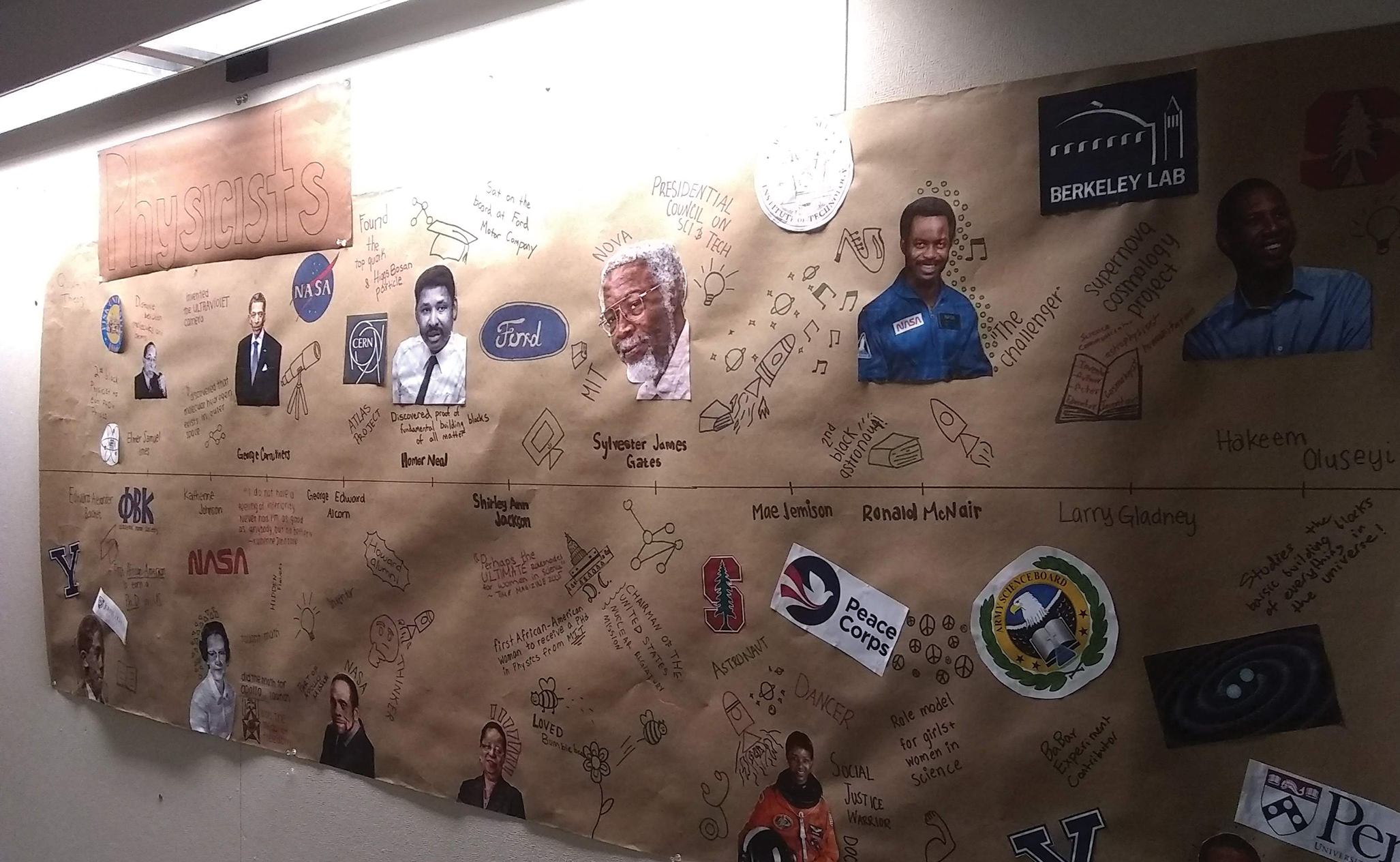
Student-created mural highlighting Black physicists throughout history.
Facilitation
As our group of teachers designed the URC, we recognized that many science teachers have minimal or no experience facilitating conversations about identity and social justice, and might feel reluctant trying to do so. For this reason, the URC includes extensive resources to help empower and support teachers in their facilitation. In this section, I summarize a few resources in the hopes of encouraging teachers to give the URC a try.
It turns out that many of the routines I had already developed as a physics teacher are useful in this novel setting. I often start a URC lesson by prompting students to reflect on what they already know about the topic for that day and what personal experiences might be relevant, and lessons generally move from individual to small group work to whole-class discussion. These are familiar patterns to the students from our prior study of physics, and help to keep our discussions engaging, inclusive, and meaningful. Throughout the year I use Peer Instruction (Mazur 1997), in which students reflect on a question, anonymously choose a response via Plickers or PollEverywhere, discuss with peers, revisit the question, and then discuss as a class to deepen their understanding, and have found that this structure works beautifully to promote discussion in the URC. In every lesson, students work in pairs or trios to reflect and share ideas, just as they do all year; in the URC, my stepping out of the center of discussion seems to open up more honest, engaged learning for my students.
Some routines do change slightly during the URC. Many science classrooms establish community norms to foster collaboration, inclusion, and learning (Chowning 2009; Windschitl, Thompson, and Braaten 2018), and I do this at the start of the year. For this unit, though, we co-construct unique norms (Figure 5) to help all students participate while making sure that everyone feels safe in the discussion.
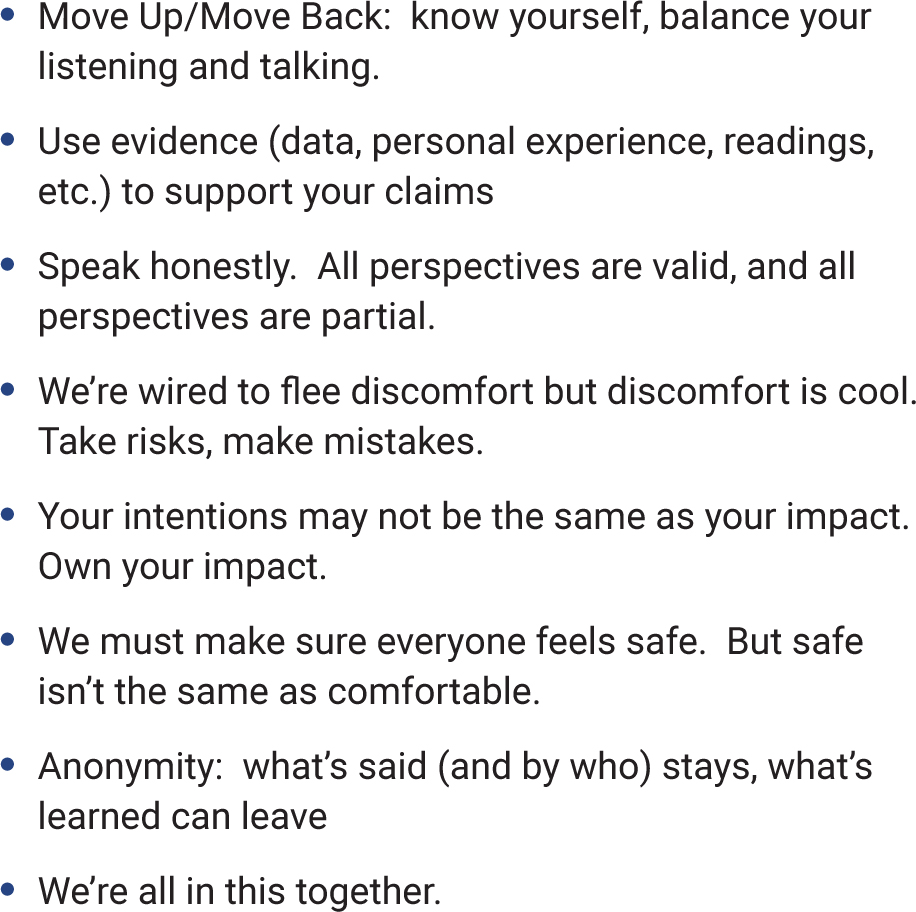
Possible discussion norms for the URC.
These norms are designed to encourage reluctant students to contribute, make sure that our discussion does not harm or marginalize, and to promote the maintenance of the learning community that we have spent the prior months building. We find that, given space and support to share their thinking, all students make significant contributions to our classroom discussions and activities, and report fantastic levels of engagement in post-unit surveys.
If I had access to the facilitation resources in the URC during my first years of implementing it, I suspect I would have gained confidence more quickly. But I also know I would have still felt nervous. Like any new thing, it’s a risk to try facilitating conversations about race in the context of physics, and it has taken time and commitment for me to grow more comfortable. For me, the risk has been worth it (especially when I consider the harms that persist if I’m not teaching for social justice). The URC is one way I answer the call to be a socially just science teacher, and like any pedagogical skill I have set out to gain, I’ve grown more skillful and more comfortable with it over time.
Teaching social justice inclusively
I initially worried that talking about underrepresentation with students might inadvertently reinforce it—would students from marginalized identities feel further marginalized? I was heartened to learn that discussing underrepresentation is a powerful way to undo its pernicious effects (Hazari et al. 2010). I take additional steps, too, to ensure that these students feel safe in our discussions by checking in beforehand and during the unit, and then afterwards using surveys to make sure things have gone as planned.
The URC lessons, however, do not exist only for the benefit of students from under-represented groups. As a white man, my implementation of the URC is likely different from that of a Latinx woman. Both of us have strengths and blind spots; recognizing the value of this unit for white students, who happen to be in the majority at my school, is one thing that my identity affords me.
For students with identities overrepresented in positions of power and in society, learning to talk comfortably about representation and society is a critical skill that they need practice to develop, and I see no reason why science class should be exempt as a setting in which students can learn this. We remind students who initially feel guilt or shame that none of us are responsible for what happened before us, but we are responsible for what we do and what we learn in our lives.
Social justice efforts are often perceived as forcing one political viewpoint or another, and about making students from privileged identities feel guilty. We have taken pains to structure lessons and assignments so that there is no “right” answer. Teacher facilitation takes the form of asking questions, not giving answers, and the class norms emphasize that being willing to listen to ideas different from yours is critically important. Many of our students will enter the STEM fields we are studying, and we expect that by helping them to see how identity and the practice of science relate to one another, we are helping them to improve the culture of science itself.
We remind students who initially feel guilt or shame that none of us are responsible for what happened before us, but we are responsible for what we do and what we learn in our lives. Many of our students will enter the STEM fields we are studying, and we expect that by helping them to see how identity and the practice of science relate to one another, we are helping them to improve the culture of science itself.
Student assessment and response
While I have concrete learning goals for the URC lessons I do with my students (Figure 3), I recognize that they are not yet part of canonical presentations of physics. For that reason, all of my assessment of student learning thus far has been formative. I respond in writing to their writing, and I use pre- and post-unit anonymous surveys to measure shifts in their understanding of the topics we discuss. Next year I plan to assess some of this learning summatively—testing to see whether my students can, for example, find an aspect they agree with in a statement they broadly disagree with (an exercise we do in a formative way throughout the URC lessons).
We have yet to perform a systematic study of the impact of the URC on students, but seven years of survey data from my own class begins to paint a powerful picture of the URC’s effects. I began doing these surveys because I believe it is important for teachers to test their own assumptions about teaching and learning, and because this was an area where I felt particularly unsure of myself. The data were aligned with my learning objectives (Figure 3), and student narrative feedback was similarly enthusiastic: By discussing [society] in physics, we are able to connect what we have learned to other things in “real life.” By learning about it, I feel less discouraged from perhaps pursuing a course in math or science.
I was particularly heartened by responses to questions about whether all students felt comfortable sharing, even when their views were unpopular: 97% said that they did.
For many years, I used these pre- and post-unit surveys to check whether students were meeting my learning objectives (Figure 3). Recently, however, I have started asking my students about how the URC changed their relationship with the discipline of physics as a whole.
As shown in the last row of Figure 6, this unit increased the proportion of my students that felt they could succeed in physics. Even if this were our only goal as science teachers (it is not), the URC would be a valuable part of our curricula.

Pre- and post-unit student data from anonymous evaluations.
Ongoing evolution
Like any good curriculum, the URC has evolved as student experiences and ideas have changed. I’ve learned to bring parents into the process—at my school, I begin the unit with a letter home explaining my plans and how they connect to my learning objectives for the entire course, and host an evening at school in which interested parents experience one of the lessons. As American politics have grown more polarized, I have put more emphasis on listening across differences through the introduction of new activities and discussion scaffolds.
The URC is continuing to grow, too, as new teachers add to the resources. Based on teacher feedback, we hope to add lessons helping interested classes explore socioeconomic class and political correctness, and expand the online discussion forums for users of the URC. Every new user is invited to join our group of curriculum editors, and we expect that the resource will continue to evolve as our community grows and diversifies.
A year into the launch of the URC, we are extremely proud of what we are making available to teachers interested in social justice in the science classroom. By going to , teachers gain free access to detailed lesson plans, including activities and resources, as well as teacher guides and resources for facilitation. Over 1,100 teachers have accessed the resources (Figure 7), from middle school to university-level science teachers, and we estimate that more than 10,000 students have experienced these lessons.
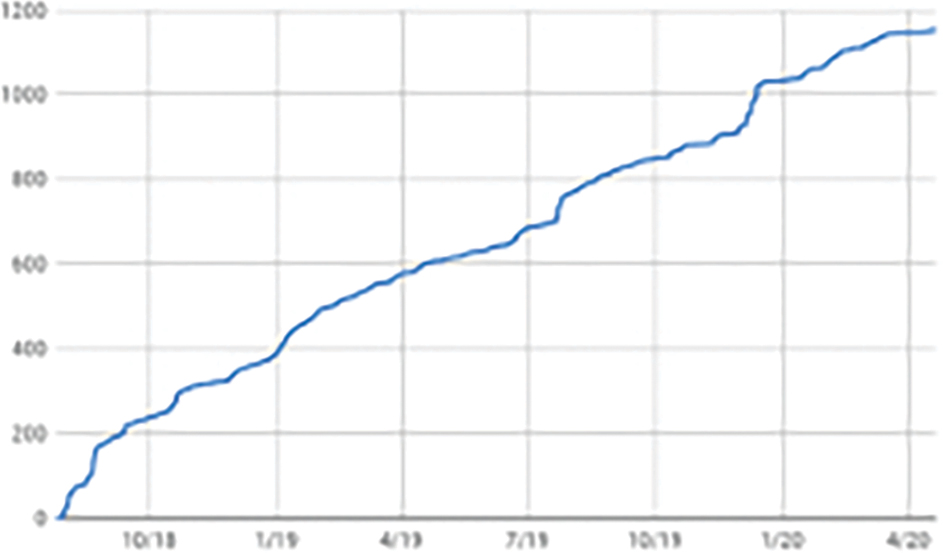
Unique requests for access to the URC by interested educators.
As science teachers, we are in a unique position to address the ways injustice influences science, society and the experiences of our students. In the powerful words of Na’ilah Suad Nasir (2016), “to not discuss or address issues of race, culture, and inequality is to accept the current patterns of inequality and marginalization.” Even though many of us have not been trained to do so, the URC offers interested teachers an engaging and science-focused way to engage in social justice teaching. Our charge to help students change the world is a daunting one, but scientists and science educators do hard things all the time. We invite interested teachers to access the resources (and to contribute to them if they are so inclined), and to make their classroom into a space of social justice transformation.
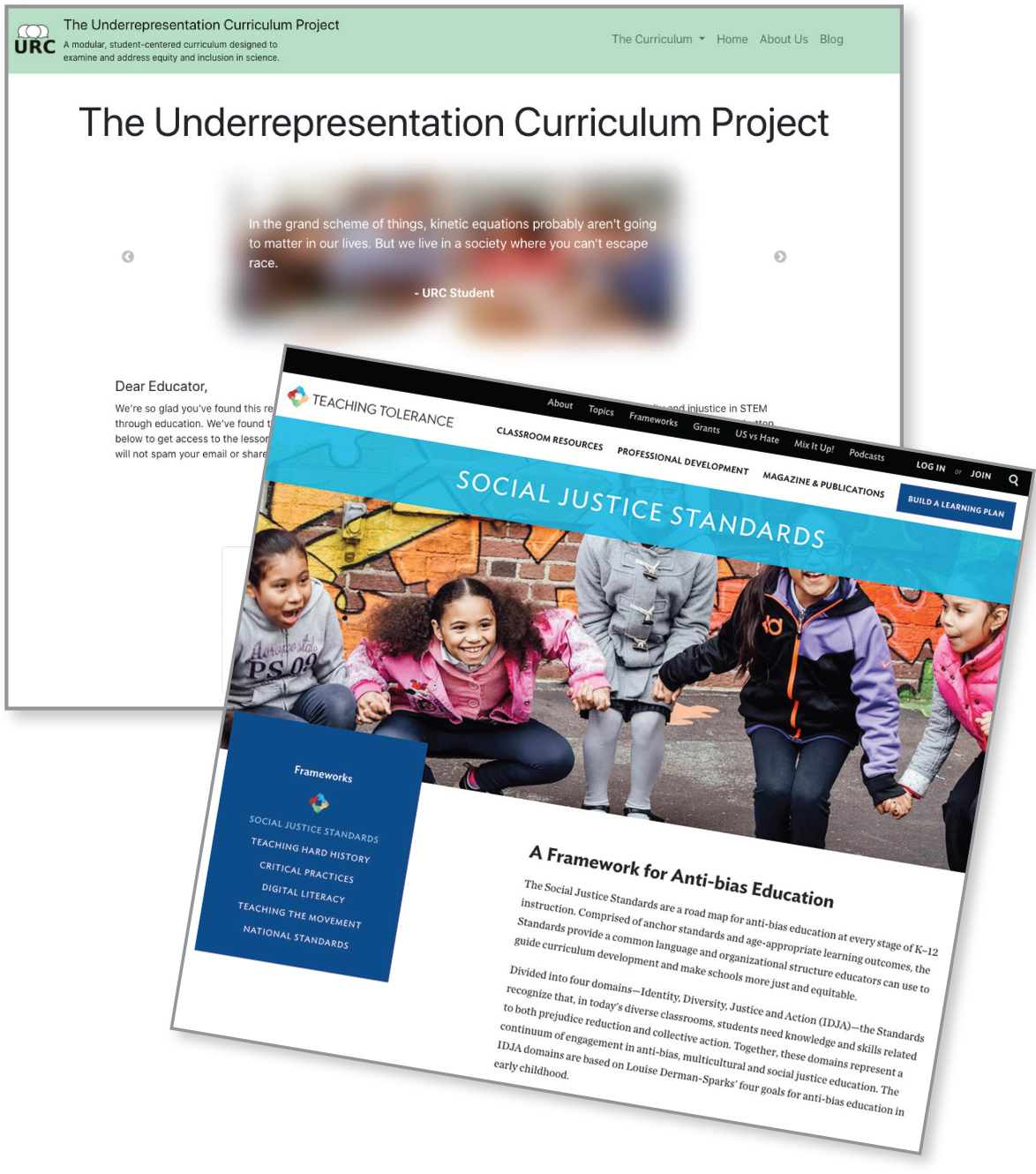
Moses Rifkin (mrifkin@universityprep.org) is a high school physics teacher at University Prep in Seattle, Washington.
Equity Inclusion Teaching Strategies High School



